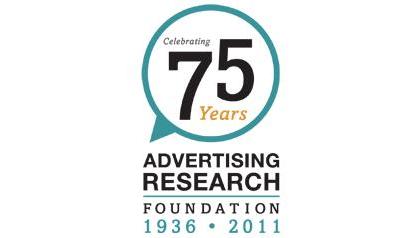ARF Insights: Advertising Research Foundation Develops Standards For Neuromarketing Research to Help Marketers Evaluate Neuro- And Biometric Market Research Methods

On March 22 at its annual convention, Re:think 2011 – Managing the Complexity Maze: Insights as the Navigator, the Advertising Research Foundation (ARF) unveiled findings from the first phase of its NeuroStandards Collaboration Project, an independent review of current neuromarketing methods, the science underlying those methods and the validity of the conclusions. In addition, a plan to continue this process and provide an "Expert Review Network," a network of independent experts to assist users of this research, was announced.
Results of this collaborative study, when fully completed, will develop standards in an emerging field that, when implemented, can help media, marketing and advertising researchers better understand how consumers react to advertising from a scientific perspective and use this knowledge to make smarter marketing decisions.
Neuromarketing garnered nationwide attention in 2003 when Read Montague, a neuroscientist at the Baylor College of Medicine, conducted a series of experiments known as the "Pepsi Challenge" using neuroscience technology to study brain activity to explore consumers' beverage preferences. Since then, there's been a significant increase in vendors employing neuromarketing, as well as in the kinds of methods and analysis techniques used in marketing research. Neuromarketing's use, however, has become problematic for marketers to assess what is actually based on the science underlying these methods and what is interpretation, according to the report released today.
The study worked with eight neuromarketing vendors across three continents to poll 18-to-49-year-olds on reactions to a series of eight commercials. Participating sponsor brands included American Express, Campbell Soup, Chase, Clorox, Colgate-Palmolive, General Motors, Hershey's and MillerCoors.
This is the first major validation study designed to assess neuroscience as it applies to media and advertising response. Methods used in this study included facial coding, biometrics, electroencephalography (EEG), quantitative EEG, facial electromyography (fEMG), steady-state topography (SST) and functional magnetic resonance imaging (fMRI). Participating neuromarketing-suppliers includedInnerscope, Mindlab International, MSW/LAB, NeuroCompass, Neuro Insight, Neurosense/decode, Sands Research and Sensory Logic. Media sponsors included ESPN, MTV Networks, NBC and Turner Broadcasting.
NeuroStandardsProject Insights:
These results indicate many reasons that an evaluation process is essential:
· Commercials and video materials contain rapidly-changing images, words and music; complex stimuli generate complex viewer reactions that can make it difficult to isolate elements that cause specific reactions
· Different images elicit reactions with different lag times: the brain reacts to the image of potential danger (such as the image of a snake) faster than less threatening imagery (a pleasant landscape). Also, the viewer's reaction at a given point may reflect anticipation of the next images rather than a reaction to images seen at that moment.
· Reactions to one scene within a commercial are likely to be influenced by the preceding content. Interactions between the images, sounds and words need to be untangled to pinpoint causes of viewer response.
· Measuring "attention" (and related reactions) is less complex than measuring specific emotions and purchase intent. Reactions to one specific region of the brain cannot always be interpreted as indicative of one specific emotion.
These insights yielded several best practice recommendations for identifying neurological and biometric methods that best meet marketers' research objectives. Additionally, it recommends that neuromarketing be employed as an addition to — not a substitute for — "traditional" research methods.
The second phase of the ARF NeuroStandards Collaboration Project, called NeuroStandards 2.0, will be detailed in a white paper planned for publication in summer 2011 and will inform strategy for the next iteration of the project, which includes a NeuroStandards Forum and special seminars for ARF members.
For more information on ARF's NeuroStandards Collaboration Project, visit http://rethink.thearf.org/pages/press.

